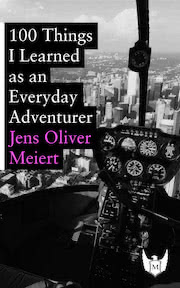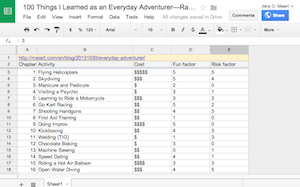Everyday Adventures: Cost, Fun, and Risk Ratings
Published on February 18, 2014 (↻ February 5, 2024), filed under Adventure (RSS feed for all categories).
100 Things I Learned as an Everyday Adventurer contains one hundred activities that I share my experience with, but that I also rate in terms of cost, fun, and risk. However, the book doesn’t make it easy to rank and compare the different activities. In the hope that it’s useful for more than just myself, there’s now also a chance to poke at the data through a Google spreadsheet.
My favorite Julia Tang then has created a little analysis (thank you!) that I like to share with you as well. Though addressed to me I like the idea that it’s of interest and use for others, too.
You had a lot of very positive experiences in which you gained positive net value (good fun with reasonable or low cost, or manageable risk): chocolate baking, painting, airsoft shooting, book-binding, arranging flowers, laser tag, drawing, drive-in theater, and ukelele.
One might objectively say that flying helicopters and operating a taser were the “worst” things you did, with the most negative net value (deemed as too risky or too costly that it outweighs whatever fun you gained). Other things that were about one standard deviation below the net value average were activities like hot air balloon, open water diving, and pepper-spraying.
You had way more activities that were a lot of fun without being as risky—that’s good.
You can take a look at some of the activities that were more risky than they were fun—that’s not good.
Fun and cost were not highly correlated—that’s good. This means it doesn’t mean that in order to have a lot of fun, you have to pay a lot of money.
Risk and cost are not highly correlated either. That means costly activities don’t necessitate additional risk, but that also means that reasonably-priced activities or cheap activities could present as much risk.
Fun and risk are most correlated among all the factors associated with your activities. If your 100 activities were any indication, then its moderate correlation would mean the higher the fun, the higher the risk, generally speaking.
Please see for yourself! And if you haven’t seen the book yet and are curious about how I’ve been spending my infinite free time and how one exactly becomes a little obsessed about trying everything, have a look at 100 Things I Learned as an Everyday Adventurer. Cheers!
About Me

I’m Jens, and I’m an engineering lead and author. I’ve worked as a technical lead for companies like Google and as an engineering manager for companies like Miro, I’m close to W3C and WHATWG, and I write and review books for O’Reilly and Frontend Dogma.
With my current move to Spain, I’m open to a new remote frontend leadership position. Feel free to review and refer my CV or LinkedIn profile.
I love trying things, not only in web development, but also in other areas like philosophy. Here on meiert.com I share some of my views and experiences.
Read More
Maybe of interest to you, too:
- Next: CSS: When to Use Generated Content
- Previous: Lessons from Writing a Dream Journal
- More under Adventure
- More from 2014
- Most popular posts
Looking for a way to comment? Comments have been disabled, unfortunately.

Find adventure anywhere? Try 100 Things I Learned as an Everyday Adventurer (2013). During my time in the States I started trying everything. Everything. Then I noticed that wasn’t only fun, it was also useful. Available at Amazon, Apple Books, Kobo, Google Play Books, and Leanpub.

